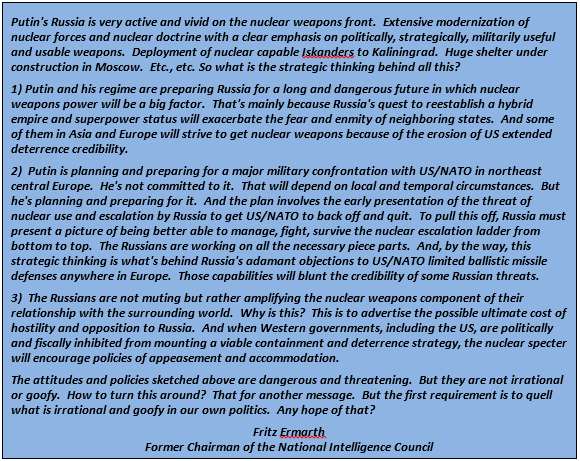“Putin is planning and preparing for a major military confrontation with US/NATO in northeast central Europe. He’s not committed to it. That will depend on local and temporal circumstances. But he’s planning and preparing for it. And the plan involves the early presentation of the threat of nuclear use and escalation by Russia to get US/NATO to back off and quit. To pull this off, Russia must present a picture of being better able to manage, fight, survive the nuclear escalation ladder from bottom to top . . .” ~Fritz Ermarth, former Chairman of the National Intelligence Council
I have written frequently about Russia’s adventurism and growing threat around the world, but particularly in the Middle East — and the Obama administration’s inept handling of that condition. Click here for a listing of my messages dealing with Russia — and here, here and here for messages a year ago that heralded these the unfolding conditions and recommended quick fixes. Regrettably, little has been done to rectify this situation — which instead has steadily gotten worse, as summarized in last week’s message about “rousing the bear.” (Click here.) This is truly the most dangerous time in my lifetime which has spanned World War II until today.
See below for an abbreviated version of my colleague’s views of the Russian Threat, no doubt reflecting lessons learned from that period, much of which dealt with evolving U.S. policies during the Cold War, against a threat that was little understood until the late 1970s. Then, Presidential Directive-59 (PD-59) instituted U.S policies that confronted the Soviet Union with a major buildup of U.S. strategic forces which had been atrophying for some time while the Soviets pursued a major modernization program — not unlike today’s U.S. strategic situation versus Russia. Fritz was one of those shepherding this important initiative. And what he is calling for now is reminiscent of those earlier times.
A Little History.
At least the Carter administration recognized that the “Détente strategy” (which it inherited from the Nixon-Ford years) was not working in our efforts to deal with the Soviet Union — and sought to understand why and what to do about it. The Strategic Arms Limitation Talks (SALT) failed to limit strategic arms as promised and the Soviet modernization efforts had overtaken and were outpacing our atrophying strategic force capabilities — reminiscent of today’s conditions. As Defense Secretary Harold Brown said at the time, “We build, they build; we stop, they build.”
Notably, the SALT II Treaty negotiated by the Carter administration, mostly in the absence of a sound underpinning strategy, only legitimized a build-up of nuclear arms that favored the Soviet Union — and the Senate refused to provide its advice and consent — so it was tabled and eventually dropped entirely by the Reagan administration in favor of seeking real reductions in nuclear arms. (Sort of like President Obama’s “NewSTART” Treaty, which a few Republicans went along with . . . regrettably.)
President Reagan’s efforts at the outset of his administration benefited from three years of serious study, initiated by Defense Secretary Brown and National Security Advisor Zbigniew Brzezinski, that led to a major policy redirection and associated defense acquisition programs. Key elements of President Carter’s 1980 Presidential Directive-59 (PD-59), were “absorbed” and incorporated into President Reagan’s National Security Decision Directive-13 (NSDD-13) very early in his administration.
This redirection was ably promoted by Reagan’s Strategic Modernization program ending the atrophying of our strategic forces — and was coupled to a major effort to counter the Soviet/Warsaw Pact military threat to NATO, including the deployment of nuclear-armed intermediate range ballistic — IRBMs (the SS-20s) that threatened our European NATO allies and our troops abroad. Arms control talks with the Soviet Union began late in the Carter administration to deal with these Intermediate Range Nuclear Forces (INF), but made little progress toward agreement—and were continued early in the Reagan administration.
U.S. INF acquisition efforts also continued the Carter administration’s effort to build ground-launched cruise missiles and Pershing II IRBMs to offset the Soviet INF forces whatever the outcome of the arms control talks.
Most importantly, the INF talks also incorporated President Reagan’s overarching policy to reduce, not limit, nuclear arms as had been the focus of previous negotiations. In particular, President Reagan proposed the total elimination of INF arms — a goal eventually achieved in spite of much ridicule along the way from the “arms control community” that wanted to compromise with the Soviets from the outset.
The Strategic Arms Reduction Talks (START) began in May 1982 to deal with the same strategic systems that had been included under SALT, but with a focus of achieving major reductions without compromises made by the Carter administration. Little happened for almost a year. Then on March 23, 1983, President Reagan introduced what became the Strategic Defense Initiative (SDI) — providing leverage to achieve the major reductions in nuclear arms he sought.
President Reagan despised the Mutual Assured Destruction (MAD) focus of Détente and wanted an alternative strategy. SDI called for building truly effective ballistic missile defense (BMD) forces — while seeking major reductions in nuclear arms — to achieve a strategic balance at a much lower level of nuclear arms, eventually he hoped even the elimination of nuclear arms.
Of great importance, he and his subsequent SDI program emphasized the potential role of space-based defenses — and that focus gave our negotiators great leverage — because the Soviets recognized the importance of space-based defenses and the fact that they could not then compete with U.S. technology.
The Soviets walked out of all arms control talks in October 1983 when we began deploying our INF missiles. The Soviets then engaged in a worldwide propaganda campaign seeking to defeat re-election of the leaders of the NATO nations that played the dominant roles in executing that deployment. They failed.
Then the SDI program and its promise brought the Soviets back to the negotiating table in March 1985, where they tried without success to get us to trade away SDI in exchange for the reductions that President Reagan wanted. They failed. And we achieved the first arms control agreements in history to actually reduce nuclear arms — both INF and START Treaties.
As I have often noted, we also developed a particular space based defense concept, called Brilliant Pebbles, which was easily the most cost-effective BMD concept to emerge from the SDI era that lasted until the beginning of the Clinton administration. Then, all efforts on space based defenses were cancelled and the most expensive and least effective BMD system concepts became the focus of subsequent development efforts.
Little has changed in over 20-years — even key technology that should trace its heritage to Brilliant Pebbles remains dormant, at least in apparent U.S. programs. Others, perhaps the Chinese, may not be so inept in exploiting modern technology to fully reap the advantages of space systems.
Implications For Today’s Challenges.
The Obama administration appears not to have a clue that its “leading from behind” policies are delusional. In only 3-months, his administration will be leaving behind conditions that are worse than the Carter administration’s legacy of a “hollow army” and atrophying strategic force capabilities. Unlike in the Carter years, there seems to be little hope that the Obama administration will leave a foundational understanding of its failures and development of policies that a follow-on administration can build upon.
Therefore, such understanding and leadership must come from somewhere else. First, we must understand the dangers we face — and the urgency of dealing with the dangers. Barring some major change within the Obama administration, hope for the future must come from outside the Obama-led government.
Among threats that must be addressed are those that come from the alliance of those who wish us ill around the world — beginning with Russia and its allies in the Middle East—notably in Syria and Iran. Thanks to Obama’s terrible Nuclear Deal, Iran is now emboldened and empowered with the removal of over a hundred billion dollars in sanctions that will permit them to outsource their dirty work and expand their role as the world’s greatest sponsor of terror.
Not the least of the consequences of this threat is that Iran or one of its outsourced surrogates could attack the United States in a way that returns us to the 19th century without the agrarian society that then sustained us. Of course, I am referring to an electromagnetic pulse (EMP) attack that would shut down our electric grid for an indefinite period. Most Americans likely would die within a year.
As Fritz concluded, we must fix what is “goofy in our own policies.”
What can you do?
Join us in praying for our nation, and for a rebirth of the freedom sought, achieved and passed to us by those who came before us.
Help us to spread our message to the grass roots and to encourage all “powers that be” to provide for the common defense as they are sworn to do.
Begin by passing this message to your friends and suggest they visit our webpage www.highfrontier.org for more information. Also, please encourage your sphere of influence to sign up for our weekly e-newsletter.
Encourage them to review our past email messages, posted on www.highfrontier.org, to learn about many details related to the existential manmade and natural EMP threats and how we can protect America against them.
Click here to make a tax deductible gift. If you prefer to mail a check, Please send it to 500 North Washington Street, Alexandria, VA 22314.
E-Mail Message 161018
Please click here to read Past Weekly Updates!
Please help High Frontier continue this important and timely work!
Be sure to follow us on our Social Sites!
If you found this letter via our Social Sites, and you would like to subscribe, please click below!






